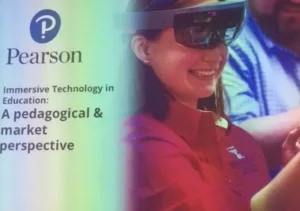With the AR/MR/VR market expected to hit $150 billion by 2020, schools, colleges and universities are now getting the hard sell on making an investment in the “next big thing.” In a well-attended SXSWedu conference, a session which afforded much less cheerleading than is usual, four accomplished AR/MR/VR luminaries held court: an academic, an artist, an ed-tech industry rep, and a publisher. The elite speakers were Fridolin Wild (a senior research fellow at Oxford Brookes University, who leads the Performance Augmentation Lab [PAL]; Linda Bush (a past academic now working as an executive director for a Pearson subsidiary; Dan Moller (a 3D artist from The Mill ); and Mark Christian (the Director of Learning and Innovation for the immersive technologies group in Pearson).
Fridolin Wild was the first speaker, speaking strongly in favor of the VR phenomenon. He reminded the audience that we now live in “the age of experience, which follows the age of commodity and the age of services.” Virtual-reality, as used in education, provides such a “memorable and personalized experience.”
Dan Moller offered another pro-VR perspective. (His company, The Mill, produced the first live-action configurable documentary, one which enables users to change the appearance of a featured car as it moves down the road.) Moller did a good job of demonstrating what can be done with AR/MR/VR today that is actually not hyped, but offers workable production potential and distribution channels. “Tailwinds from game development have pushed VR further than AR at this stage.”
However, the real story here is that those of us in attendance got a good look at what Pearson, the huge educational publishing conglomerate, thinks about the AR/MR/VR market and where they are placing their business bets. In fact, the photo snap below suggests these thoughts were ported directly out of an internal presentation at Pearson:
Linda Bush played the role of a critical friend to the technology, yet at the same time revealed the inner thinking of a large publishing company, by asking: “Where do we see the most promise and potential; and how do we not lose time and stray too far by getting caught up in the shiny object of the moment?” She explained: “Every day I talk to faculty that wants a more immediate immersive learning experience for their students; they want experts students can go to at any time and interact with and learn.”
Still, Bush agreed that “almost every content area imaginable can be enhanced, improved, or fixed in some way with an AR/MR/VR experience.” “I have never heard the word ‘WOW’ expressed so much, as when students are viewing VR.” She added: “With AR/MR/VR in education I see an opportunity for synergy in which the whole can be greater than the sum of the parts; and we are approaching an incredibly exciting time, if we remember what our priorities are.”
The most interesting part of Bush’s presentation involved a survey of faculty and student priorities for AR/MR/VR. Apparently, students:
- don’t want to lose human interaction
- want to share in learning, and not be isolated
- want to learn how to make it themselves (creating the apps)
When presented with the same survey, university faculty offered an identical set of responses to those above, but added the following pedagogical desirables:
- knowing how to use it in the classroom
- resources that are easy to “plug into” curriculum
- true enhancements to what educators are doing today, not just add-ons
- customization capabilities
- the need for control
- remembering what our priorities are
 But then Bush began counterpunching. She suggested (as most traditional educators will): “There will always be a place for personalized, interactive traditional classroom instruction. She continued: “I am a bit of a fence sitter, although a fairly engaged one.” She ended with a cautious note: “the pedagogy should drive the application of our technology, not the other way around.”
But then Bush began counterpunching. She suggested (as most traditional educators will): “There will always be a place for personalized, interactive traditional classroom instruction. She continued: “I am a bit of a fence sitter, although a fairly engaged one.” She ended with a cautious note: “the pedagogy should drive the application of our technology, not the other way around.”
The session ended with some striking comments by the Mark Christian of the Pearson immersive technologies group. Talking about wearables in specific, he announced that VR is expected to grow in 2017, but then will start to dip. At that time, many more AR applications will be released and these will greatly outnumber VR applications. “We had some great success with VR, but I’m personally and professionally more interested in AR. AR is the future.” There you have it. Straight from the horse’s mouth. –Len Scrogan

